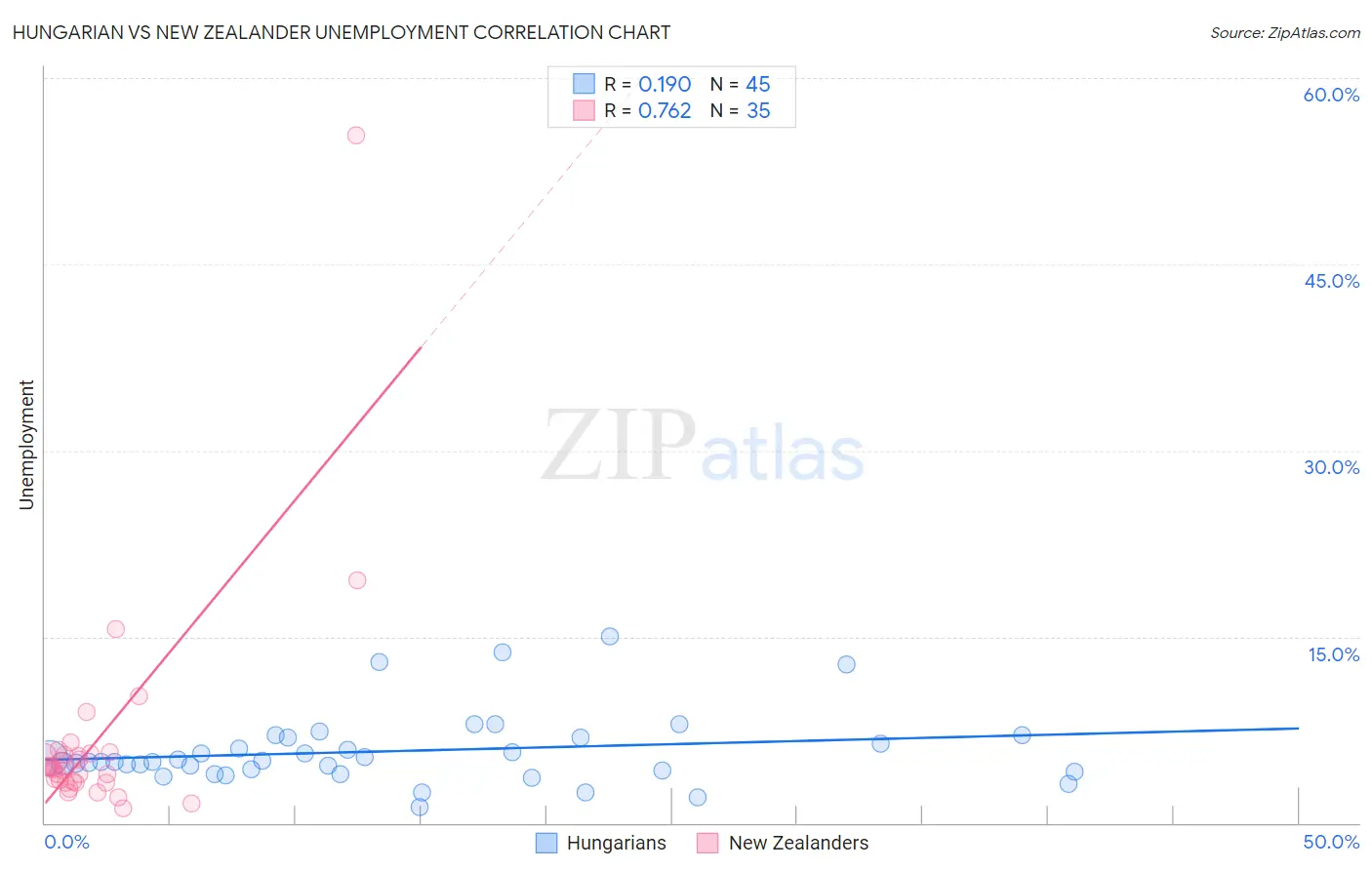Hungarian vs New Zealander Unemployment
COMPARE
Hungarian
New Zealander
Unemployment
Unemployment Comparison
Hungarians
New Zealanders
5.0%
UNEMPLOYMENT
96.9/ 100
METRIC RATING
86th/ 347
METRIC RANK
4.9%
UNEMPLOYMENT
98.6/ 100
METRIC RATING
67th/ 347
METRIC RANK
Hungarian vs New Zealander Unemployment Correlation Chart
The statistical analysis conducted on geographies consisting of 485,022,206 people shows a poor positive correlation between the proportion of Hungarians and unemployment in the United States with a correlation coefficient (R) of 0.190 and weighted average of 5.0%. Similarly, the statistical analysis conducted on geographies consisting of 106,884,587 people shows a strong positive correlation between the proportion of New Zealanders and unemployment in the United States with a correlation coefficient (R) of 0.762 and weighted average of 4.9%, a difference of 1.4%.

Unemployment Correlation Summary
| Measurement | Hungarian | New Zealander |
| Minimum | 1.3% | 1.2% |
| Maximum | 15.0% | 55.4% |
| Range | 13.7% | 54.2% |
| Mean | 5.8% | 6.6% |
| Median | 4.9% | 4.4% |
| Interquartile 25% (IQ1) | 4.2% | 3.3% |
| Interquartile 75% (IQ3) | 6.9% | 5.6% |
| Interquartile Range (IQR) | 2.7% | 2.3% |
| Standard Deviation (Sample) | 2.9% | 9.2% |
| Standard Deviation (Population) | 2.9% | 9.1% |
Demographics Similar to Hungarians and New Zealanders by Unemployment
In terms of unemployment, the demographic groups most similar to Hungarians are Immigrants from Australia (5.0%, a difference of 0.030%), Russian (5.0%, a difference of 0.31%), Hmong (5.0%, a difference of 0.39%), Fijian (5.0%, a difference of 0.40%), and Basque (5.0%, a difference of 0.41%). Similarly, the demographic groups most similar to New Zealanders are Slavic (4.9%, a difference of 0.030%), Slovak (4.9%, a difference of 0.040%), Immigrants from North America (4.9%, a difference of 0.12%), Serbian (4.9%, a difference of 0.27%), and Immigrants from Japan (4.9%, a difference of 0.33%).
| Demographics | Rating | Rank | Unemployment |
| Slovaks | 98.7 /100 | #66 | Exceptional 4.9% |
| New Zealanders | 98.6 /100 | #67 | Exceptional 4.9% |
| Slavs | 98.6 /100 | #68 | Exceptional 4.9% |
| Immigrants | North America | 98.5 /100 | #69 | Exceptional 4.9% |
| Serbians | 98.4 /100 | #70 | Exceptional 4.9% |
| Immigrants | Japan | 98.3 /100 | #71 | Exceptional 4.9% |
| Burmese | 98.3 /100 | #72 | Exceptional 4.9% |
| Paraguayans | 98.3 /100 | #73 | Exceptional 4.9% |
| Immigrants | Northern Europe | 98.2 /100 | #74 | Exceptional 4.9% |
| Turks | 98.0 /100 | #75 | Exceptional 4.9% |
| German Russians | 98.0 /100 | #76 | Exceptional 4.9% |
| Cypriots | 97.9 /100 | #77 | Exceptional 4.9% |
| Okinawans | 97.9 /100 | #78 | Exceptional 4.9% |
| Canadians | 97.7 /100 | #79 | Exceptional 5.0% |
| Immigrants | Sweden | 97.6 /100 | #80 | Exceptional 5.0% |
| Basques | 97.6 /100 | #81 | Exceptional 5.0% |
| Fijians | 97.6 /100 | #82 | Exceptional 5.0% |
| Hmong | 97.6 /100 | #83 | Exceptional 5.0% |
| Russians | 97.4 /100 | #84 | Exceptional 5.0% |
| Immigrants | Australia | 97.0 /100 | #85 | Exceptional 5.0% |
| Hungarians | 96.9 /100 | #86 | Exceptional 5.0% |